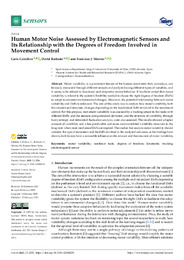Por favor, use este identificador para citar o enlazar este ítem:
https://hdl.handle.net/11000/34264Registro completo de metadatos
| Campo DC | Valor | Lengua/Idioma |
|---|---|---|
| dc.contributor.author | Caballero, Carla | - |
| dc.contributor.author | Moreno, Francisco Javier | - |
| dc.contributor.author | Barbado, David | - |
| dc.contributor.other | Departamentos de la UMH::Ciencias del Deporte | es_ES |
| dc.date.accessioned | 2025-01-10T09:08:58Z | - |
| dc.date.available | 2025-01-10T09:08:58Z | - |
| dc.date.created | 2023 | - |
| dc.identifier.citation | Sensors | es_ES |
| dc.identifier.issn | 1424-8220 | - |
| dc.identifier.uri | https://hdl.handle.net/11000/34264 | - |
| dc.description.abstract | Motor variability is a prominent feature of the human movement that, nowadays, can be easily measured through different sensors and analyzed using different types of variables, and it seems to be related to functional and adaptative motor behavior. It has been stated that motor variability is related to the system’s flexibility needed to choose the right degrees of freedom (DoFs) to adapt to constant environmental changes. However, the potential relationship between motor variability and DoFs is unknown. The aim of this study was to analyze how motor variability, both the amount and structure, changes depending on the mechanical DoFs involved in the movement control. For this purpose, movement variability was assessed by a tracking sensor in five tasks with different DoFs, and the amount, using standard deviation, and the structure of variability, through fuzzy entropy and detrended fluctuation analysis, were also assessed. The results showed a higher amount of variability and a less predictable and more auto-correlated variability structure in the long-term when more mechanical DoFs are implied. The studies that analyze motor variability should consider the type of movement and the DoFs involved in the analyzed task since, as the findings have shown, both factors have a noticeable influence on the amount and the structure of motor variability. | es_ES |
| dc.format | application/pdf | es_ES |
| dc.format.extent | 10 | es_ES |
| dc.language.iso | eng | es_ES |
| dc.publisher | MDPI | es_ES |
| dc.relation.ispartofseries | 23 | es_ES |
| dc.relation.ispartofseries | 4 | es_ES |
| dc.rights | info:eu-repo/semantics/openAccess | es_ES |
| dc.rights | Attribution-NonCommercial-NoDerivatives 4.0 Internacional | * |
| dc.rights.uri | http://creativecommons.org/licenses/by-nc-nd/4.0/ | * |
| dc.subject | motor variability | es_ES |
| dc.subject | nonlinear tools | es_ES |
| dc.subject | degrees of freedom | es_ES |
| dc.subject | kinematic | es_ES |
| dc.subject | tracking | es_ES |
| dc.subject | electromagnetic sensor | es_ES |
| dc.subject.other | CDU::7 - Bellas artes::79 - Diversiones. Espectáculos. Cine. Teatro. Danza. Juegos.Deportes | es_ES |
| dc.title | Human Motor Noise Assessed by Electromagnetic Sensors and Its Relationship with the Degrees of Freedom involved in Movement Control | es_ES |
| dc.type | info:eu-repo/semantics/article | es_ES |
| dc.relation.publisherversion | https://doi.org/10.3390/s23042256 | es_ES |

Ver/Abrir:
2023_JCR_22_Sensors_Human Motor Noise Assessed by Electromagnetic Sensors and.pdf
832,71 kB
Adobe PDF
Compartir:
 La licencia se describe como: Atribución-NonComercial-NoDerivada 4.0 Internacional.
La licencia se describe como: Atribución-NonComercial-NoDerivada 4.0 Internacional.
.png)